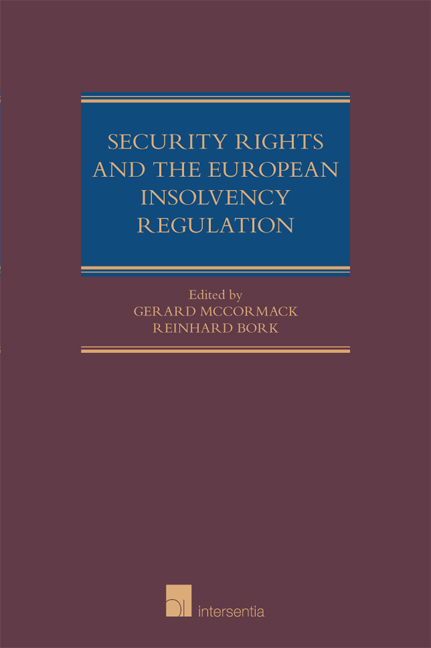Book contents
- Frontmatter
- Disclaimer
- Preface
- Contents
- Questionnaire
- Table of Cases
- Table of Abbreviations
- Part I Comparative Analysis
- Introduction
- Chapter 1 Security Rights under Article 5 of the Insolvency Regulation and Article 8 of theRecast
- Chapter 2 Transactional Avoidance and the Insolvency Regulation
- Chapter 3 Security Rights, National Laws and Possible Reforms
- Chapter 4 Transactional Avoidance, National Laws and Possible Reforms
- Part II National Reports
- Index
- List of Authors
Chapter 2 - Transactional Avoidance and the Insolvency Regulation
from Part I - Comparative Analysis
Published online by Cambridge University Press: 21 September 2018
- Frontmatter
- Disclaimer
- Preface
- Contents
- Questionnaire
- Table of Cases
- Table of Abbreviations
- Part I Comparative Analysis
- Introduction
- Chapter 1 Security Rights under Article 5 of the Insolvency Regulation and Article 8 of theRecast
- Chapter 2 Transactional Avoidance and the Insolvency Regulation
- Chapter 3 Security Rights, National Laws and Possible Reforms
- Chapter 4 Transactional Avoidance, National Laws and Possible Reforms
- Part II National Reports
- Index
- List of Authors
Summary
This chapter will consider Articles 4(2)(m) and 13 of the Insolvency Regulation – Regulation 1346/2000 – and the equivalent provisions in the‘recast’ Regulation, Regulation (EU) 2015/848. These provisions deal with transactional avoidance. Article 4 sets up the possibility for transactional avoidance while Article 13 provides a defence. Aft er a brief section setting out the policy background, the main body of the chapter will consider the scope of application of Articles 4 and 13. The third section will consider options for reform of the relevant provisions.
INTRODUCTION
Transactional avoidance in insolvency situations is a feature of all the legal systems considered in this report. This is so for a number of different reasons, all of them related to the achievement of insolvency objectives, namely the enforcement of the system of priorities laid down by insolvency law; sanctioning the debtor‘s intention to defraud creditors; the protection of creditors against any actions detrimental to the insolvency estate; and finally assisting in the restructuring of the debtor‘s business. The Court of Justice has classified these actions as’ actions which derive directly from those proceedings and which are closely connected to them‘. By the same token, Article 4(2)(m) establishes that’ the rules relating to the voidness, voidability or unenforceability of legal acts detrimental to all the creditors‘are subject to the law governing the insolvency proceedings, i.e. the lex fori concursus.
Nevertheless, and to safeguard the expectations of third parties and the certainty of transactions, Article 13 lays down that‘Article 4(2)(m) shall not apply where the person who benefited from an act detrimental to all the creditors provides proof that: the said act is subject to the law of a Member State other than that of the State of the opening of proceedings, and that law does not allow any means of challenging that act in the relevant case’. While transactional avoidance entails the impugning of apparently valid acts, this provision aims to protect legal certainty by making sure that the last word on the validity of an act or transaction is pronounced by the law governing it, i.e. the lex causae.
- Type
- Chapter
- Information
- Security Rights and the European Insolvency Regulation , pp. 45 - 60Publisher: IntersentiaPrint publication year: 2017

